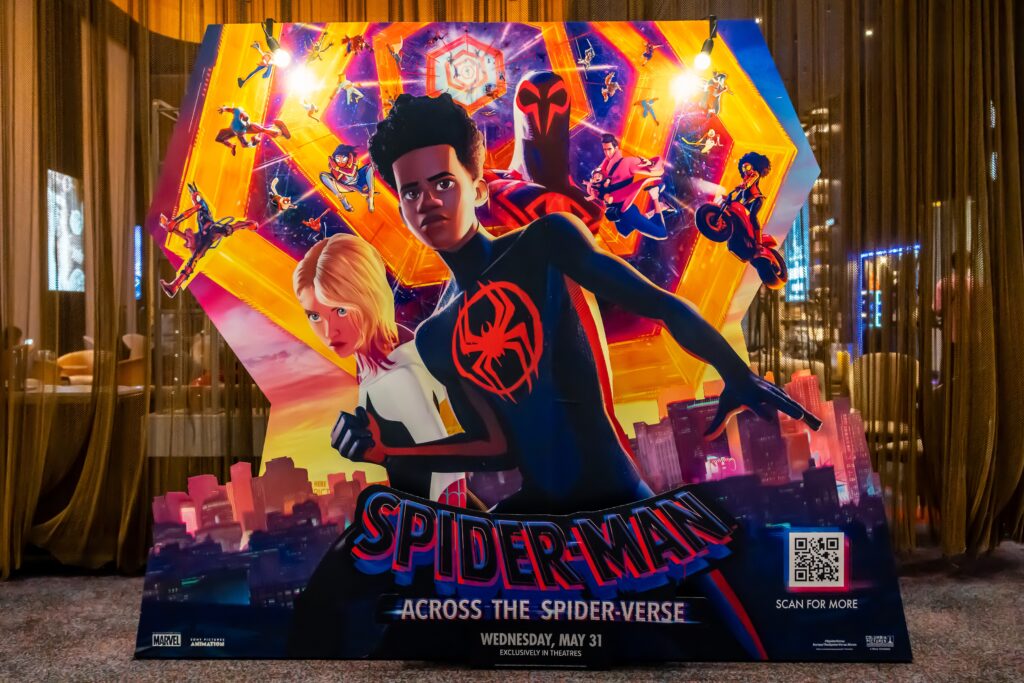It’s the ‘The Empire Strikes Back’ or ‘The Godfather Part II’ of animated films. Spider-Man: Across the Spider-Verse is a highly anticipated sequel to a movie that seemed untouchable.
Over the past two decades, it feels like a new Spider-Man film has been released every year, but in 2018, ‘Spider-Man: Into the Spider-Verse’ surpassed them all. It stands out as one of the rare superhero animations on the big screen, and it was the first to explore the concept of alternate universes.
The follow-up to the remarkable Into the Spider-Verse exhibits a peculiar combination of frenzied busyness and sluggish pacing, according to Nicholas Barber. However, Barber acknowledges that the film’s ingenuity and artistry remain awe-inspiring.
Besides, it was the only one to capture the diverse visual styles and techniques found in a stack of comics. Certain parts appeared like they were painted, some were hand-drawn, and others resembled prints on inexpensive paper, complete with the distinctive Ben-Day dots seen in Roy Lichtenstein’s paintings. This film was a game-changer, an extraordinary Pop-Art spectacle that pushed the boundaries of the medium. Notably, all these innovative elements were seamlessly intertwined with a heartfelt story and endearing characters.
What’s the main plot of ‘Spider-Man: Across the Spider-Verse?’
The Spider-Verse follows the story of Miles Morales, a teenager hailing from Brooklyn, who embraces the mantle of Spider-Man in his own universe. To his surprise, Miles discovered the existence of countless other universes, each inhabited by their own web-slinging heroes. Among them were the familiar Peter Parker, the endearing Gwen Stacy, the comical Spider-Ham, and the mysterious Spider-Man Noir, who existed in a timeless black-and-white realm.
Now, in the highly anticipated sequel, “Spider-Man: Across the Spider-Verse,” the narrative delves even deeper into the multiverse. Miles encounters an astonishing array of Spider-People, including a punk rebel from London who always appears as if he belongs on a worn-out poster, and an Indian Spider-Man from an alternate reality where Manhattan and Mumbai coexist as one. As the roster of heroes expands, Miles learns that these extraordinary individuals have established their own cutting-edge headquarters. From this base, they diligently monitor “anomalies” across the multiverse under the leadership of the gruff Spider-Man of the year 2099, Miguel O’Hara.
In this thrilling sequel, “Spider-Man: Across the Spider-Verse,” the boundaries of Miles Morales’ adventure extend far beyond his own universe. With a multitude of Spider-Men and Spider-Women joining forces, their mission to protect the multiverse reaches new heights.
The Spider-Man: Across the Spider-Verse is an Ambitious Yet ‘Overwhelming’ Sequel
In a continuation of its predecessor’s brilliance, “Across the Spider-Verse” showcases astonishing creativity and meticulous craftsmanship that leaves other animated films pale in comparison.
However, this time around, the abundance of these elements becomes its own stumbling block. Co-written by renowned producers Phil Lord and Christopher Miller (known for “The Lego Movie”), the film starts with a prologue centered on Gwen’s conflicts with her police officer father (Shea Whigham) and her battle against an interdimensional Vulture (Jorma Taccone) from an alternate 16th century. Unfortunately, this section extends for too long.
Similarly, in Miles’s universe, a sequence unfolds involving his clashes with his own police officer father (Brian Tyree Henry) and his encounters with The Spot (Jason Schwartzman), an initially clumsy supervillain who gains the ability to open portals into other dimensions. Sadly, this section also overstays its welcome, with both the frenetic fights and solemn monologues lingering well past their necessary duration.
Perhaps the inevitable outcome was a tinge of disappointment – it’s nearly impossible for any sequel to match the groundbreaking nature of “Into the Spider-Verse.”
This isn’t to say that “Across the Spider-Verse” lacks momentum—it packs every frame with breathtaking visuals and clever humor. However, it simultaneously feels hyperactively busy and frustratingly sluggish. It takes a staggering 50 minutes before Gwen and Miles finally reunite, and it requires at least another half-hour before they reach the Spider-People HQ that has been prominently featured in the trailers.
The principal villain, The Spot, remains conspicuously absent for much of the film. Yet, the most glaring instance of the film’s excessive tendencies is that, despite its nearly two-and-a-half-hour runtime, it only reaches the midpoint of its narrative. The film concludes on a cliffhanger, accompanied by a caption announcing the upcoming sequel, “Spider-Man: Beyond the Spider-Verse,” leaving viewers more exhausted than exhilarated.
How could any sequel match the groundbreaking nature of “Into the Spider-Verse”?
Spider enthusiasts will be enthralled by the self-indulgence displayed in the highly anticipated “Spider-Man: Across the Spider-Verse.” There’s no doubt they’ll find themselves eagerly rewatching and pausing to unravel the countless allusions that span over six decades of comics, cartoons, live-action films, and video games.
However, those who are not well-versed in the Spider-Man universe might find themselves perplexed. While its predecessor, “Into the Spider-Verse,” skillfully blended futuristic science-fiction elements with the relatable life of a troubled teenager from Brooklyn, this sequel fully embraces the artificiality of its world. Its central, postmodern theme revolves around the concept of the multiverse and how the intricate web of various Spider-Man narratives interconnects. Relating to this narrative becomes challenging, especially if one is not a universe-hopping comic-book superhero.
Perhaps a sense of slight disappointment was inevitable. How could any sequel live up to the groundbreaking nature of “Into the Spider-Verse”? Moreover, in the four and a half years since its release in 2018, the exploration of super-powered action in alternate universes has been addressed in films like “Teen Titans Go! vs. Teen Titans,” “Doctor Strange in the Multiverse of Madness,” “Spider-Man: No Way Home,” and the Oscar-winning “Everything Everywhere All At Once.”
What was once a mind-bending original now feels somewhat familiar. However, the primary reason why “Across the Spider-Verse” falls short of its predecessor is quite simple: it lacks the presence of Spider-Ham.

